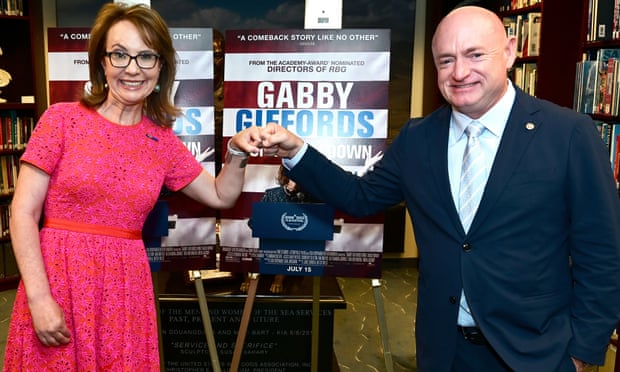‘Keep moving forward’: Gabby Giffords on recovery, gun control and a new movie
The documentary Gabby Giffords Won’t Back Down traces the former congresswoman’s improbable recovery and activism in the wake of a devastating shooting

Gabby Giffords Won’t Back Down, a new documentary about the former congresswoman turned gun control activist, opens on the National Mall dotted with bouquets like a somber orchard – 40,000 white flowers for lives lost to gun violence in the US in 2019, 5,000 orange ones for the increase in 2020. She walks with a limp and a cane, the result of partial paralysis on her right side following an attempted assassination in 2011. Her face, altered by the injuries from a gunshot wound to the head and several life-saving surgeries, bears a grim recognition.
Gabby Giffords Won’t Back Down, directed by RBG film-makers Betsy West and Julie Cohen, is as much about America’s unrelenting and preventable epidemic of gun violence, for which Giffords is both a dauntless activist and grim statistic, as well as Giffords’s improbable recovery. It has been 11 years since a gunman opened fire at one of her constituent meet-and-greets, killing six and leaving Giffords in critical condition with a bullet through the left hemisphere of her brain, where language function resides.
In the years since, Giffords relearned to walk, to speak and to communicate with aphasia – a condition which limits one’s ability to use or understand language, which affects over 2 million Americans (including the actor Bruce Willis), often as a result of strokes or brain tumors. She returned to Congress to advocate for long overdue gun reform in the wake of Sandy Hook, which ultimately did not pass; she has traveled the country on behalf of her foundation, Giffords, working to pass gun control legislation and counter-program the NRA. She bikes, plays the French horn and sings along perfectly to pop songs. And, as the film captures first-hand, she returned to the campaign trail in support of her husband of 15 years, the former astronaut Mark Kelly, during his successful bid for US Senate from Arizona in 2020.
“This is a film, obviously, about an activist who is working to try and solve this horrible epidemic of gun violence in our country,” co-director West, sitting next to Cohen and Giffords in the latter’s Tucson living room, told the Guardian via Zoom. “But it is also, at its core, a tremendously personal story. A comeback story, of somebody who really faced such a challenge, the worst thing that could possibly happen short of being killed. And coming back from that, how did that happen? How did she do it?” Giffords said she had learned, through 11 years of recovery and disability, “to be grateful for friends and family, and to live every day to the fullest”. (Because of Giffords’s aphasia, which limits her ability to spontaneously communicate verbally, the Guardian agreed to questions ahead of time.)
Most Americans are probably somewhat familiar with the day that changed Giffords’s life: on 8 January 2011, Giffords, then 40, was hosting a meet-and-greet outside a Safeway in her hometown of Tucson when Jared Loughner, a 22-year-old with a history of paranoid schizophrenia, opened fire. Despite a history of erratic, disruptive behavior, Loughner passed a background check and legally purchased a Glock semi-automatic weapon six weeks prior. Earlier that morning, a salesperson at a Tucson Walmart, concerned by Loughner’s agitated behavior, lied and said the store was out of the ammunition he asked for; Loughner then went to another Walmart, purchased eight boxes of 9mm ammunition for $83, and went to the Safeway.
He killed six people: Christina Taylor-Greene, nine; Dorothy “Dot” Morris, 76; federal judge John Roll, 63; Phyllis Schneck, 79; Dorwan Stoddard, 76; and Gabe Zimmerman, Giffords’s 30-year-old community outreach director. Giffords, shot through the head, was saved by immediate first aid from staffer Daniel Hernandéz Jr; within the hour, doctors at University medical center in Tucson removed a large portion of her skull to ease pressure on her brain.
The film picks up during her immense recovery process at Memorial Hermann medical center in Houston, where she traveled for rehab, via home video shot by Kelly. “I thought at some point, whether it was a year or 10 years later, Gabby was going to want to see what she went through,” Kelly says in the film. The footage is raw, at once hopeful and dispiriting. Nineteen days after the shooting, head shorn from surgery, Giffords smiles on command and manages a slight thumbs up. Three weeks out, she struggles to form the mouth shape to blow air into a pinwheel. Thirty days after the shooting, she’s able to say her name and sing along to some lyrics from songs (music, the film explains, is an important part of aphasia therapy as it uses parts of the brain outside the language center.) Five weeks out, she’s able to complete sentences but perseverating, for unknown reasons, on the word “chicken”; unable to say “happy birthday” to her husband without adding “chicken”, she breaks down in sobs.
A decade later, Giffords and Kelly watch, on camera, these videos from the early days of recovery with a sense of humor, able to laugh now at the randomness of “chicken”. There’s a throughline of determination and awe for the long road of Giffords’s recovery, from surgery to the daily rhythms of therapy. At one point, the film-makers interweave footage of Kelly’s docking of the Endeavor space shuttle at the International Space Station – a tricky hours-long procedure which requires manually flying two vehicles within 2in of each other – to the doctors in Houston who perfectly reconstructed and fit a prosthetic for the missing part of Giffords’s skull. (The two extremely risky and precise operations occurred on the same day.) Flash forward to 2020, Giffords is in a Zoom meeting with her longtime speech therapist, Fabi Hirsch, in which the two practice, word by slow word, lines for a Kelly campaign ad: “Marriage is a commitment.” Later, following Kelly’s victory, she advises on his maiden speech in their kitchen: slow down, shoulders back, slow down. The two have a “symbiotic relationship”, West said. “They help each other a lot.” Giffords described Kelly as her “best friend” with a wry sense of humor.

Cohen and West wondered if a film on gun control activism, in a country that repeatedly fails to pass meaningful reform at the federal level, where the supreme court recently struck down state-level concealed carry laws, would be too much of a downer. “Is it going to be so depressing that it wouldn’t be fun to watch?” Cohen said of their concerns. “And the answer to that concern is Gabby herself. Making this film was so much fun.”
Given the intransigence of the issue – it has taken nearly three decades and two more recent devastating mass shootings (in Uvalde, Texas and Buffalo, New York) for Congress to pass a law just to meaningfully strengthen background checks this summer – does Giffords ever want to give up? “No way, Jose,” she answered. “Move ahead to not look back.”
“We want people to think seriously about the epidemic of gun violence and the possibility of making some change, of not just giving up,” Cohen added of the film. “We want people to understand more about aphasia and learn a little bit about the brain, but the main thing we want is for people to come out of this theater feeling really motivated and really, really good. That’s how we felt, spending time with Gabby, and that’s how we want all audiences to feel.”
“For me it has been really important to move ahead, to not look back,” Giffords said. “I hope others are inspired to keep moving forward no matter what.”
-
Gabby Giffords Won’t Back Down is now out in US cinemas with a UK date to be announced

